poster
106 Products
Active Filters
Filter by Category
Filter by Color
Filter by Price
Min Price:
Max Price:
-
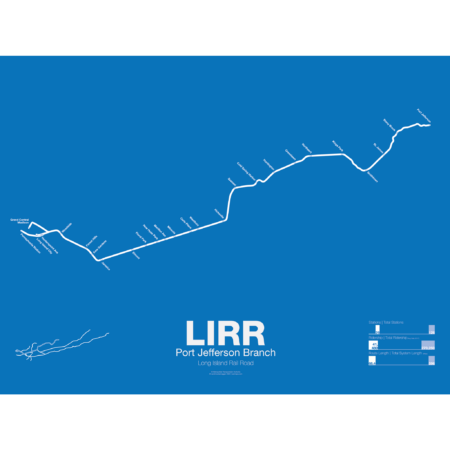
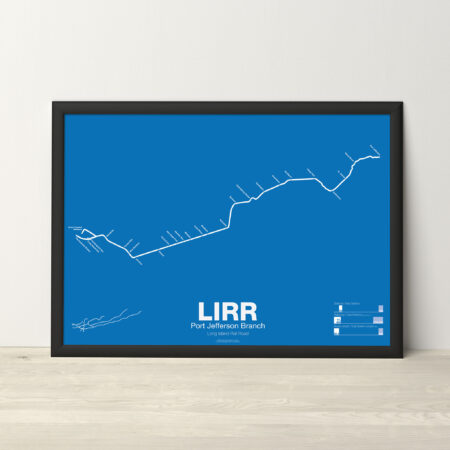 $30.00 – $80.00
$30.00 – $80.00The LIRR Port Jefferson Branch is a branch off the Main Line at Hicksville and was opened to Syosset in 1854. The line was extended to Northport in 1868 but due to disputes between the LIRR and the towns of Cold Spring and Huntington the new line bypassed both. In 1873 the line was extended to Port Jefferson but branched off south of Northport, leaving the original terminal a spur line that would be abandoned by 1899. In 1895 the line was extended a final time to Wading River with plans on continuing it to Riverhead, though this was never done. The Wading River extension was eventually abandoned in 1938. Due to rising ridership the LIRR is constructing a third track along the Main Line from Floral Park to Hicksville so many Port Jefferson and Ronkonkoma trains can run express to Jamaica.
Printed on Satin finish 80# cover stock – 220 GSM. Made in the USA! Standard production time is 5 days. Allow more time for shipping.
Select options This product has multiple variants. The options may be chosen on the product page -
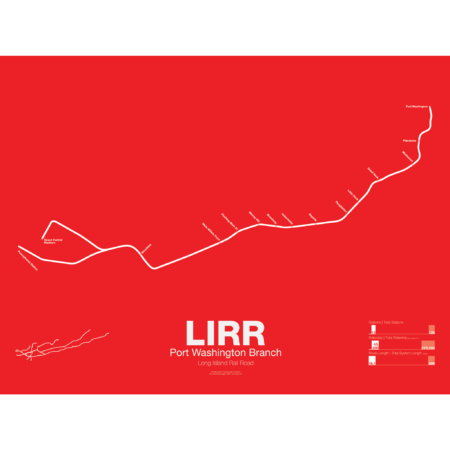
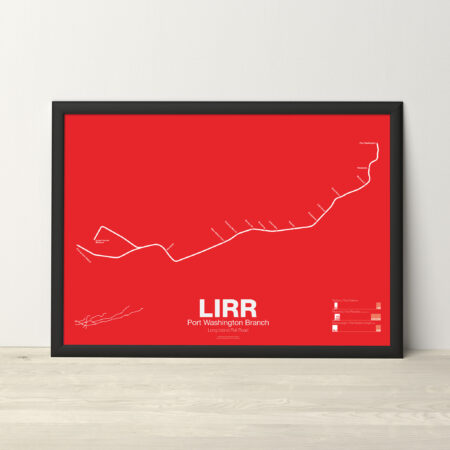 $30.00 – $80.00
$30.00 – $80.00The LIRR Port Washington Branch runs from Penn Station to Port Washington through Flushing and is the only LIRR branch that does not run through Jamaica. Built and opened by the Flushing RR in 1854 it was the first non-LIRR railroad on Long Island. Originally the line was supposed to reach Roslyn, Oyster Bay and Huntington but this was thwarted by the LIRR which reached there first. By 1874 the Flushing RR had combined with other competitors to form the Flushing, North Shore and Central Railroad but in two years would be bought by the LIRR. Additionally there was a branch to Whitestone but this was eliminated in 1932.
Printed on Satin finish 80# cover stock – 220 GSM. Made in the USA! Standard production time is 5 days. Allow more time for shipping.
Select options This product has multiple variants. The options may be chosen on the product page -
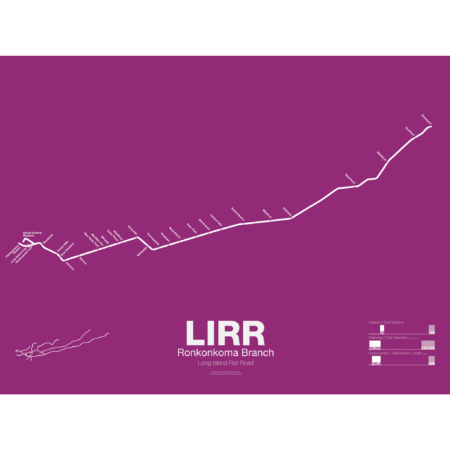
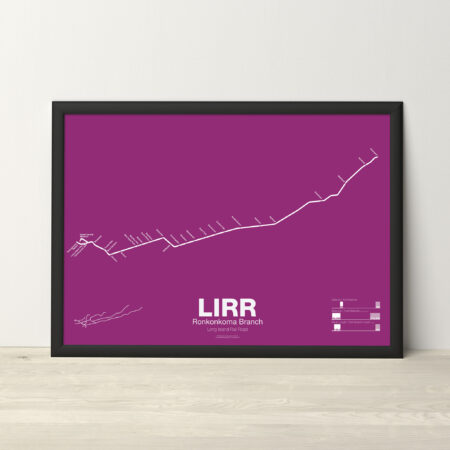 $30.00 – $80.00
$30.00 – $80.00The LIRR Ronkonkoma Branch is the service which runs along most of the original Main Line of the LIRR from Brooklyn to Greenport through Hicksville. Service today runs to Ronkonkoma with shuttle service continuing to Greenport. The original Main Line opened from Brooklyn to Jamaica in 1836 and was extended to Hempstead in 1839. By 1844 the line had been extended out to Greenport with ferry service to New England. At the time train technology was thought too primitive to navigate the rough terrain of the Connecticut coast so a train-ferry-train service was devised to travel between New York and Boston. The LIRR Main Line ran as straight as possible down the center of Long Island, avoiding existing towns, to have the fastest service. But in 1848 a railroad was opened through Connecticut and the LIRR was now a railroad to nowhere. Over the next 30 years the LIRR grew by buying up the competition and by 1880 had a monopoly on Long Island. Today the LIRR is the oldest railroad in the country which still operates from its original charter.
Printed on Satin finish 80# cover stock – 220 GSM. Made in the USA! Standard production time is 5 days. Allow more time for shipping.
Select options This product has multiple variants. The options may be chosen on the product page -
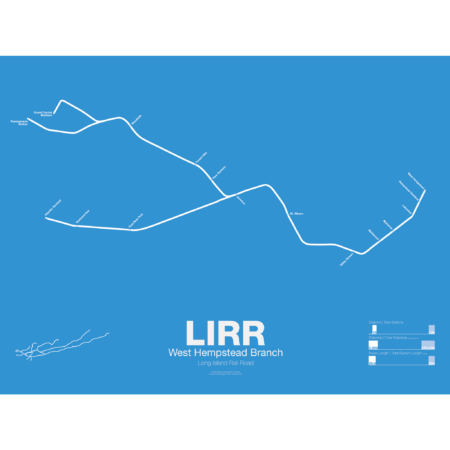
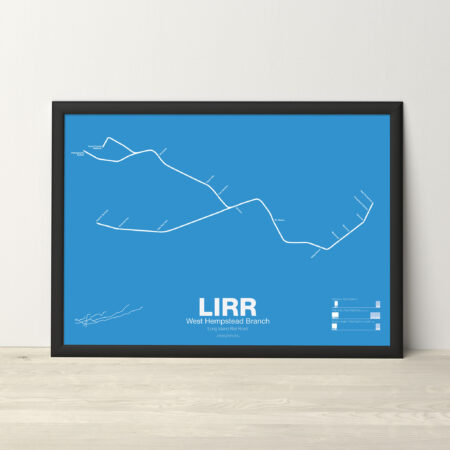 $30.00 – $80.00
$30.00 – $80.00The LIRR West Hempstead Branch is a short, single track line which runs from Valley Stream to West Hempstead. Most service is run as a shuttle but a few trains are through run at peak times. The West Hempstead Branch was opened by the New York Bay Extension RR Company as part of a larger, unrealized line from Brooklyn to Garden City. The line originally had complex connections to the Hempstead Branch, Main Line, and Oyster Bay Branch so that many different services could be run. Eventually these connections were eliminated due to the need for grade separation.
Printed on Satin finish 80# cover stock – 220 GSM. Made in the USA! Standard production time is 5 days. Allow more time for shipping.
Select options This product has multiple variants. The options may be chosen on the product page -
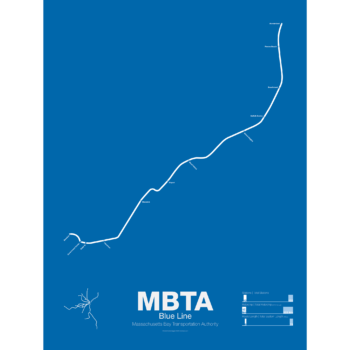
 $30.00 – $80.00
$30.00 – $80.00The Blue Line started off as a trolley tunnel to connect Scollay Sq. in downtown Boston to Maverick Sq. in East Boston. It holds the distinction as the first underwater transit tunnel (under a major body of water) opening in 1904. Initial plans called for it to be connected to the Green Line to form a subway trolley network connection all points north, east, south, and west. However, in 1924, the line was converted to heavy rail and extended to Bowdoin Sq. The Blue Line diverted traffic away from East Boston ferries which, ironically, helped bring the demise to the Atlantic Ave elevated line.
Until the 1950s the Blue Line was connected to the Red Line at Charles St so that Blue Line trains could be serviced at the Red Line train shops in Harvard Sq. In 1952 the Blue Line was extended to Suffolk Downs along the abandoned Boston, Revere Beach and Lynn Railroad and two years later extended to Revere where it still terminates at Wonderland.
Printed on Satin finish 80# cover stock – 220 GSM. Made in the USA! Standard production time is 5 Days. Please add more time for shipping.
Select options This product has multiple variants. The options may be chosen on the product page -
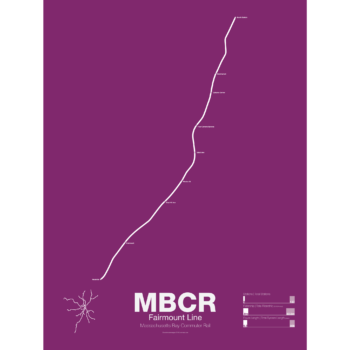
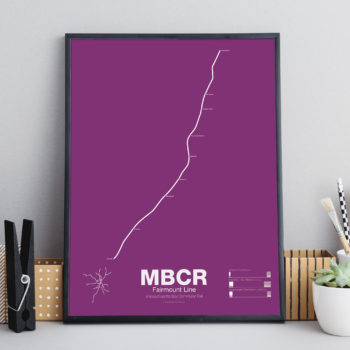 $30.00 – $80.00
$30.00 – $80.00The Fairmount Line is the shortest MBTA commuter rail line and the only one which runs entirely within the city limits of Boston. Originally built as part of the Norfolk County Railroad, the line opened in 1855 and was extended to Walpole, Franklin and Providence. Originally the line ran through South Boston and across the Fort Point Channel to reach its terminal. By 1898 the line had been leased to J.P. Morgan’s NY, New Haven and Hartford Railroad and when South Station opened the following year the original alignment through South Boston was abandoned. Passenger service was ended in 1944 but when the MBTA was building their Southwest Corridor rail project (rebuilding the Orange Line and Amtrak’s Northeast Corridor) they upgraded the Fairmount Line and rerouted all passenger service starting in 1979. When the Southwest Corridor opening in 1987 all service south of Readville was rerouted and the Fairmount Line was reduced to a shuttle. In the early 2000s planners and community advocates proposed adding stations and more service to the line to act as a new subway line, the Indigo Line. Four new stations were added as well as additional service but service remains less than rapid transit levels (mostly due to the use of diesel engines) and fares are higher than that of the subway and bus, limiting potential ridership.
Printed on Satin finish 80# cover stock – 220 GSM. Made in the USA! Standard production time is 5 days. Allow more time for shipping.
Select options This product has multiple variants. The options may be chosen on the product page -
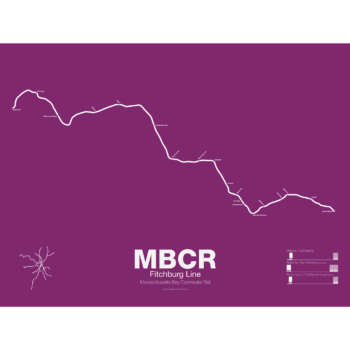
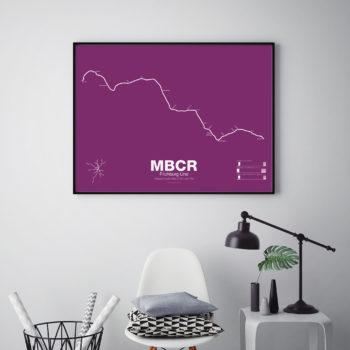 $30.00 – $80.00
$30.00 – $80.00The Fitchburg Line opened between 1840 and 1845 connecting Boston and Fitchburg. The line was extended along the northern frontier of the state before briefly running through southern Vermont on its way to Troy, NY. Traffic on the line slowed after World War 2 and by the 1960s service had been cut back as far as West Concord. After substantial investment by the state, service to Gardner was opening in 1980 but cut back again, this time to Fitchburg in 1987. In 2016 service was extended to Wachusett. The Fitchburg is the second longest line in the commuter rail system but due to decades of deferred maintenance the line suffers from the worst on time performance. Many stations are not ADA compliant and the line features many tight curves through the mountains. Until 2017 the line also had about 9 miles of single track segments which limited capacity, although today only a short section through Waltham remains single tracked.
Printed on Satin finish 80# cover stock – 220 GSM. Made in the USA! Standard production time is 5 days. Allow more time for shipping.
Select options This product has multiple variants. The options may be chosen on the product page -
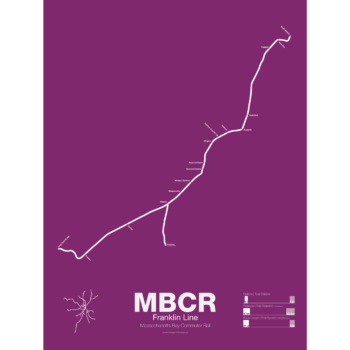
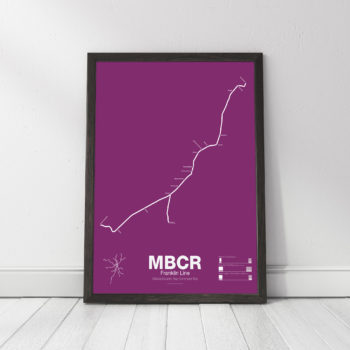 $30.00 – $80.00
$30.00 – $80.00The Franklin Line was original built as part of the Norfolk County Railroad, the line opened in 1855. Originally the line ran through South Boston and across the Fort Point Channel to reach its terminal. By 1898 the line had been leased to J.P. Morgan’s NY, New Haven and Hartford Railroad and when South Station opened the following year the original alignment through South Boston was abandoned. Passenger service ran from New York City via Waterbury and Hartford, CT but by 1966 service had been cut back to Blackstone, MA. The MBTA required towns not within their district to subsidize service themselves and only Franklin was willing to do so. Service was extended to Forge Park/495 in 1988 which was part of a separate railroad. Today service runs to Boston via the Northeast Corridor, although some rush hour trains use the Fairmount Line. Service to Foxboro is run only for football games and special events, although a new pilot program featuring weekday service to Foxboro is now being tested.
Printed on Satin finish 80# cover stock – 220 GSM. Made in the USA! Standard production time is 5 days. Allow more time for shipping.
Select options This product has multiple variants. The options may be chosen on the product page -
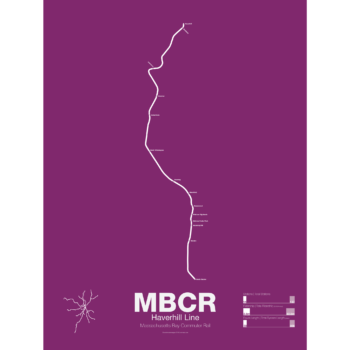
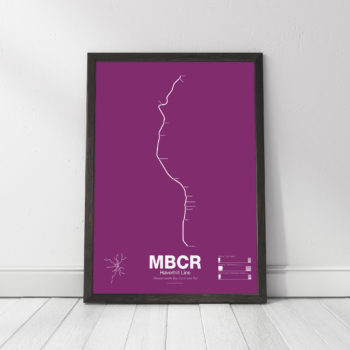 $30.00 – $80.00
$30.00 – $80.00The Haverhill Line was part of the Boston & Maine Railroads first line as the Andover & Haverhill Railroad in 1837. It was later extended to Portland, Maine in 1839. In 1959 passenger service between Wilmington and Boston was ended and all service to Haverhill and beyond was moved over to the Wildcat Branch which connected to the Lowell Line in Wilmington. The newly formed MBTA drew up plans to rebuild the section from Reading to Boston as a relocated and expanded Orange Line. Community opposition and limited funds meant that the Orange Line extension north ended at Oak Grove. Because of the compromise between Orange Line and commuter rail, much of the line to Reading is single tracked which forces some trains to use the Wildcat Branch.
Printed on Satin finish 80# cover stock – 220 GSM. Made in the USA! Standard production time is 5 days. Allow more time for shipping.
Select options This product has multiple variants. The options may be chosen on the product page -
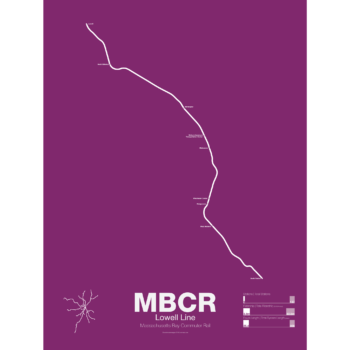
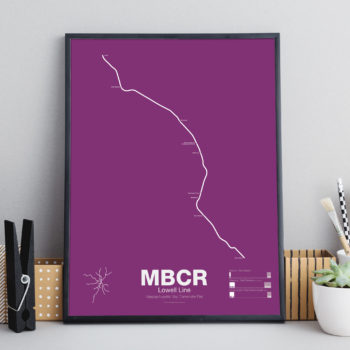 $30.00 – $80.00
$30.00 – $80.00The Lowell Line was one of the first railroads in the United States opening as the Boston & Lowell in 1835 to service the Lowell textile mills. The line was expanded and soon reached all the way to Canada. The Boston & Maine acquired the railroad in 1895. The line was bought by the MBTA in 1973. Service was briefly extended to Concord, NH in 1981 but was ended when federal funding was withdrawn.
Printed on Satin finish 80# cover stock – 220 GSM. Made in the USA! Standard production time is 5 days. Allow more time for shipping.
Select options This product has multiple variants. The options may be chosen on the product page -
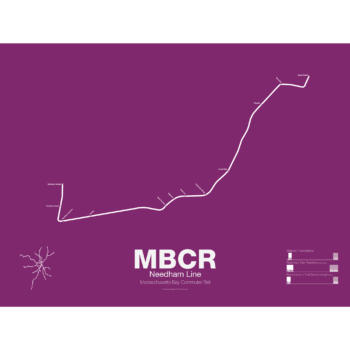
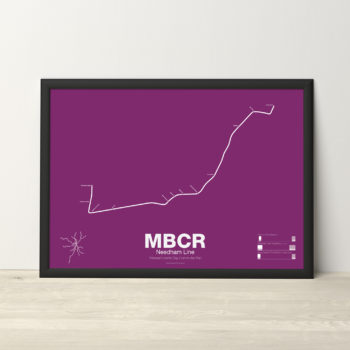 $30.00 – $80.00
$30.00 – $80.00The Needham Line is the second shortest MBTA commuter rail branch and the only one which was never part of a larger intercity line. First opened as a branch of the Boston & Providence Railroad in 1834, the line ran through West Roxbury to Dedham where it connected back to the Main Line in Hyde Park. A second railroad, the Charles River Branch, was built through Newton and Needham in 1853 and was used to haul gravel from Needham quarries to fill in the Back Bay. The Needham Cutoff, connecting the two railroads, was opened in 1906 and was run as a loop between Boston and it’s growing western suburbs. When the MTA, the predecessor of the MBTA, opened the Riverside “D train” Green Line branch in 1959 the loop service was ended. When the MBTA drew up plans to relocate its Orange Line elevated train to a new subway along the proposed Southwest Expressway (which was canceled in 1971) it planned to convert the Needham Line into a branch of the new Orange Line. Community opposition and a lack of funds stopped such an extension but the Orange Line tracks extend along the Needham Line past Forest Hills as provisions for a future conversion.
Printed on Satin finish 80# cover stock – 220 GSM. Made in the USA! Standard production time is 5 days. Allow more time for shipping.
Select options This product has multiple variants. The options may be chosen on the product page -
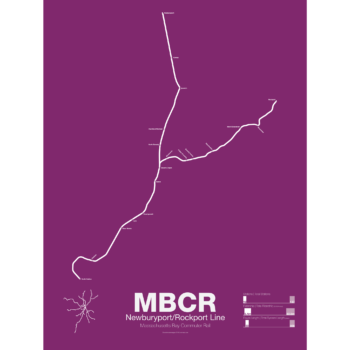
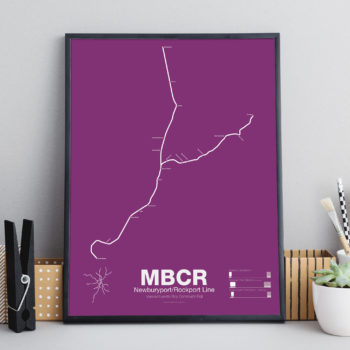 $30.00 – $80.00
$30.00 – $80.00The Newburyport/Rockport Line was part of the Eastern Railroad which connected Boston and Portsmouth, NH in 1836. The branch to Rockport opened to Gloucester in 1847 and was extended to Rockport in 1861. Originally the line ran to East Boston where passengers would continue to Boston proper via ferry. When the Grand Junction Railroad opened in 1854 trains gained access to Boston via Charlestown. The Boston & Maine Railroad leased the line in 1884 and was acquired by the MBTA in the 1970s. Service was slowly cut back over the next decade but the line was upgraded and service to Newburyport restored by 1998.
Printed on Satin finish 80# cover stock – 220 GSM. Made in the USA! Standard production time is 5 days. Allow more time for shipping.
Select options This product has multiple variants. The options may be chosen on the product page -
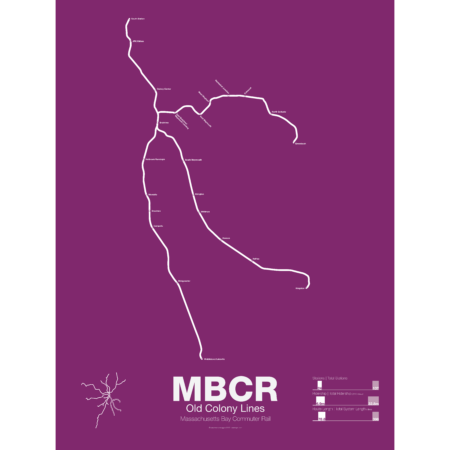
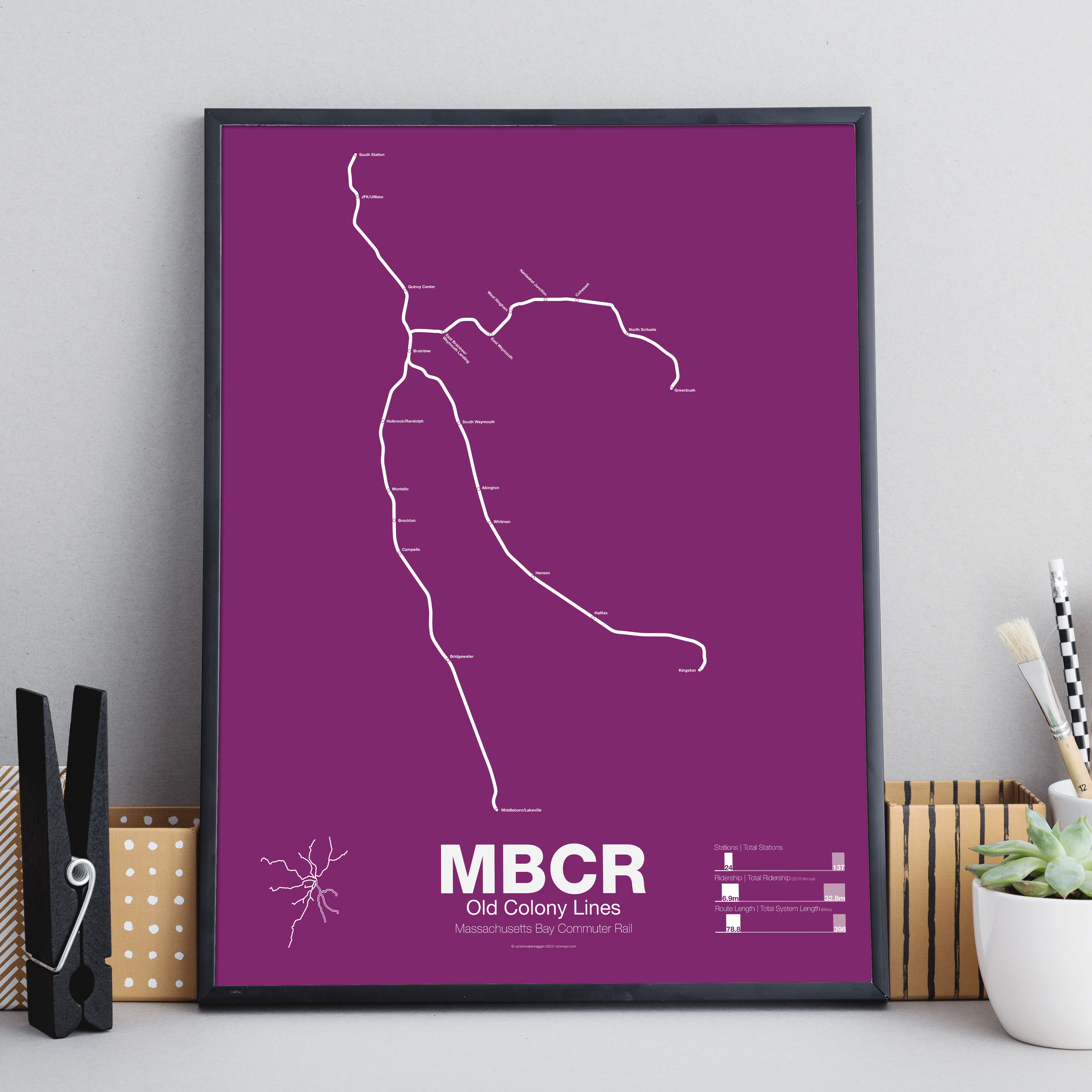 $30.00 – $80.00
$30.00 – $80.00The Old Colony Lines are all that remain of the Old Colony Railroad which served southern Massachusetts and Cape Cod. The first line ran to Plymouth in 1845 with a second branch to Fall River via Middleborough opening in a year later. Service to Fall River was part of a “boat train” where passengers would board a steamship to New York City. The Greenbush Branch opened in 1849 as a separate charter under the South Shore Railroad but this was separated from the Old Colony in 1854. By 1893 J.P Morgan’s NY, New Haven and Hartford Railroad had taken control of both railroads. In 1958, due to financial difficulty, the NYNH&H stopped all passenger service on the Old Colony Lines, stranding riders and growing south shore suburbs. The MTA, and its successor the MBTA, saw the potential of extending rapid transit service along the former railroad and designed a more suburban oriented subway line which used large park-and-ride facilities to appeal to suburban drivers. The MBTA Red Line was extended to Quincy in 1971 and Braintree in 1980. Commuter rail service to Plymouth and Middleborough was restored by 1997. The Greenbush branch, which was in worse shape than the others, took another decade to open. When the Middleborough branch was being rebuilt, plans included extending service as far as Buzzards Bay but were ultimately scrapped due to funding. Today service to Cape Cod is provided by the CapeFLYER from Memorial Day to Columbus Day as a joint operation by the MBTA and CCRTA, although no official MBTA commuter rail service has been adopted.
Printed on Satin finish 80# cover stock – 220 GSM. Made in the USA! Standard production time is 5 days. Allow more time for shipping.
Select options This product has multiple variants. The options may be chosen on the product page -
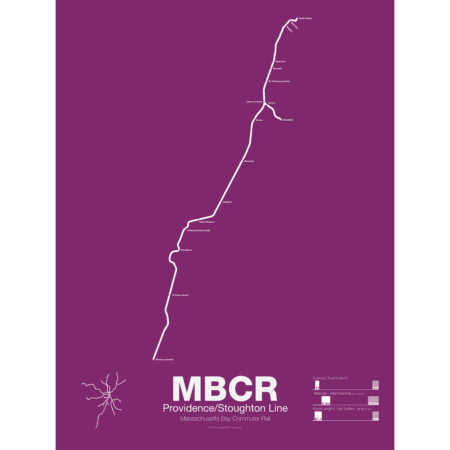
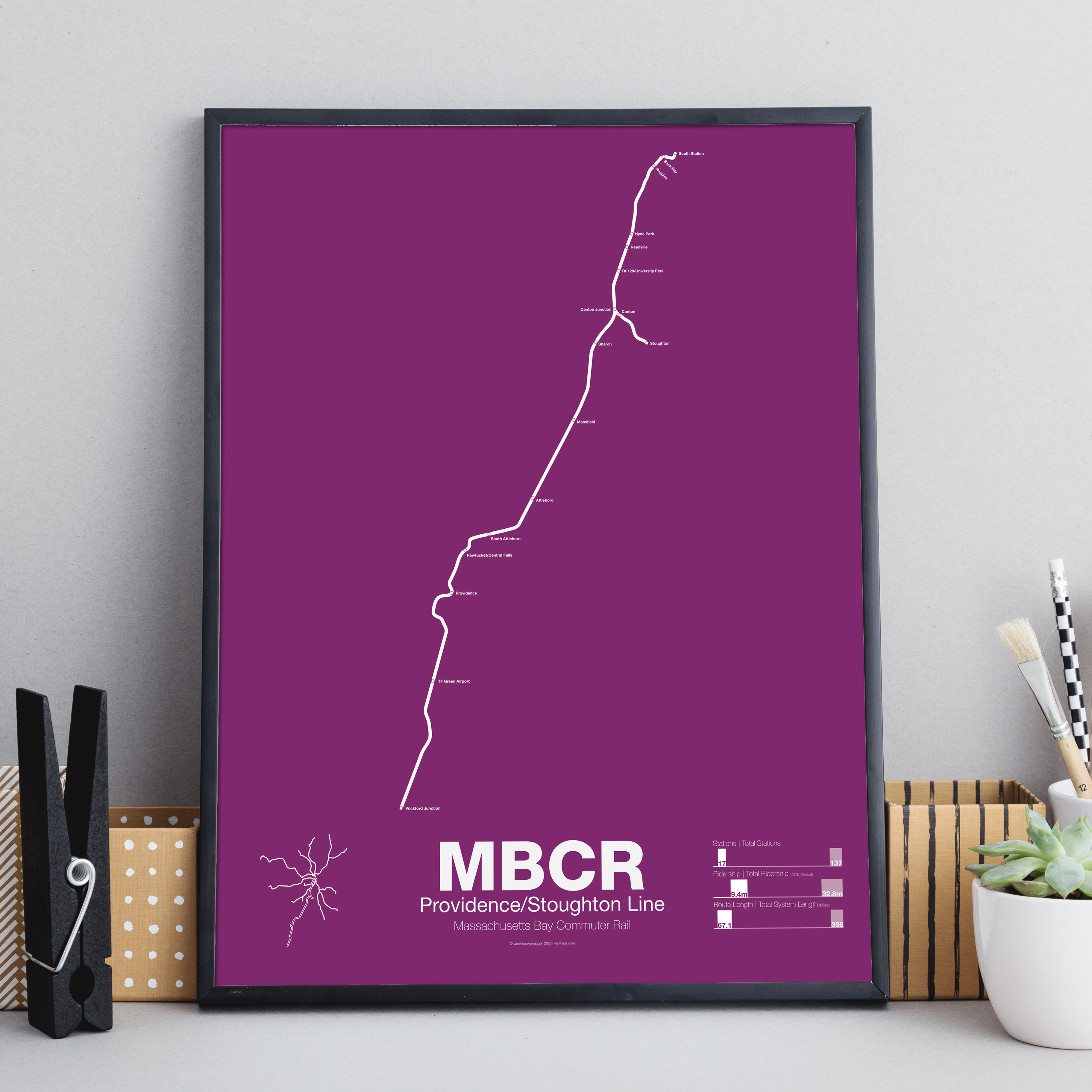 $30.00 – $80.00
$30.00 – $80.00The Providence/Stoughton Line was one of the first railroads in the United States chartered as the Boston & Providence Railroad in 1831. Running through the Jamaica Plain section of Roxbury the railroad helped transform the area into one of the first suburbs in America. Originally the line had to cross the Back Bay between Roxbury and Boston on a viaduct and its depot was built at Park Sq, then filled in land on the coast of the city. When the Back Bay was filled in the street layout was designed around the diagonal run of the Boston & Providence tracks. In 1888 the B&P was leased to the Old Colony Railroad which itself was leased by J.P. Morgan’s NY, New Haven & Hartford Railroad in 1893. In the 1970s, after being bought by the Penn Central and then Conrail, the Providence-Boston route was bought by the MBTA. In 2012 service was extended to Wickford Junction, RI. Service from Providence to Foxboro is run for football games and special events. The Stoughton branch has only two stations but will be extended south to Fall River and New Bedford as part of the South Coast Rail project now under construction.
Printed on Satin finish 80# cover stock – 220 GSM. Made in the USA! Standard production time is 5 days. Allow more time for shipping.
Select options This product has multiple variants. The options may be chosen on the product page -
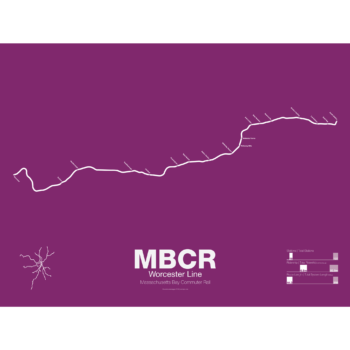
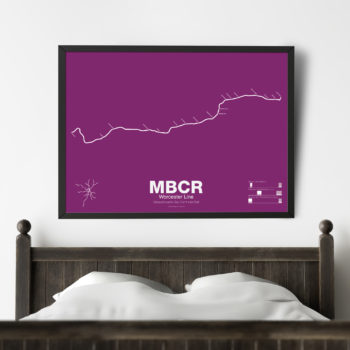 $30.00 – $80.00
$30.00 – $80.00The Worcester Line first opened as the Boston and Worcester Railroad in 1834 and was one of the first railroads with commuter-oriented service. Once part of the Boston and Albany Railroad service was extended to New York and beyond. The line had four tracks from Boston through Newton but when the Massachusetts Turnpike was extended to Boston in 1964 the line was reduced to two tracks and many of the H.H. Richardson stations were demolished to make way for the highway. The Boston and Albany rail yard in Back Bay was sold off and redeveloped as the Prudential Center with the Worcester Line running through the development. Service to between Albany and Worcester was ended in 1970 but restored in 1975. The Worcester Line is not entirely owned by the MBTA and suffers from delays by freight trains and poor quality track. Because of this many trains are short turned at Framingham, which is the limit of MBTA ownership. Two new stations within Boston have opened recently, the Boston Landing station to serve the New Balance headquarters in Brighton and the Landsdown (previously Yawkey) station to serve Fenway. A new station has been proposed in Allston, West Station, as part of a new transit oriented development.
Printed on Satin finish 80# cover stock – 220 GSM. Made in the USA! Standard production time is 5 days. Allow more time for shipping.
Select options This product has multiple variants. The options may be chosen on the product page -
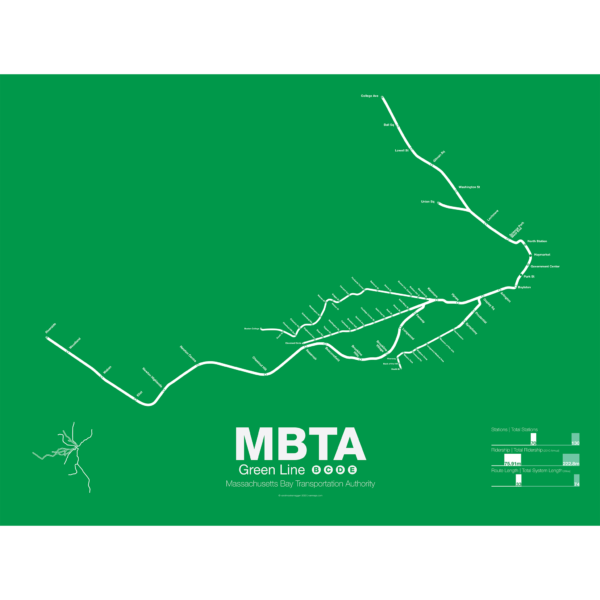
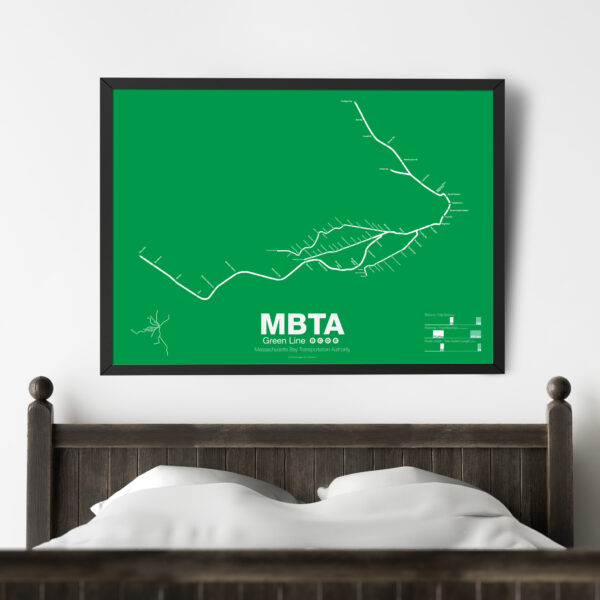 $30.00 – $80.00
$30.00 – $80.00The Green Line is part of the oldest subway in the United States. The short section between Boylston St and Park St opened in 1897 as a way to divert heavy trolley traffic which came downtown from Allston, Brighton, Brookline, Jamaica Plane, Roxbury, and Dorchester. It was quickly expanded to North Station to serve trolley traffic from the northern suburbs.
As commuting patterns changed due in part to the success of the subway the Green Line was extended west to Kenmore Sq and in the 1940s southwest along Huntington Ave. As more and more commuters chose to travel in private automobiles ridership on the trolleys dropped. In 1959 the Riverside branch was opened along a former commuter rail line through Newton. A rebranding of the MBTA system in 1967 renamed the branches that were left as the A, B, C, D, and E branches. The A branch to Watertown Sq. only lasted two more years before finally being axed in 1969.
Boston College B Branch trains run along Commonwealth Ave to Government Center; Cleveland Cirlce C Branch trains run along Beacon St to North Station; Riverside D Branch trains run along the Riverside line through Newton to Government Center; Heath St E Branch trains run along Huntington Ave to Lechemere. Construction has begun on a long planned extension northwest through Somerville which will bring the E branch to Union Sq and the D to College Ave-Tufts University.
Printed on Satin finish 80# cover stock – 220 GSM. Made in the USA! Standard production time is 5 Days. Please add more time for shipping.
Select options This product has multiple variants. The options may be chosen on the product page

